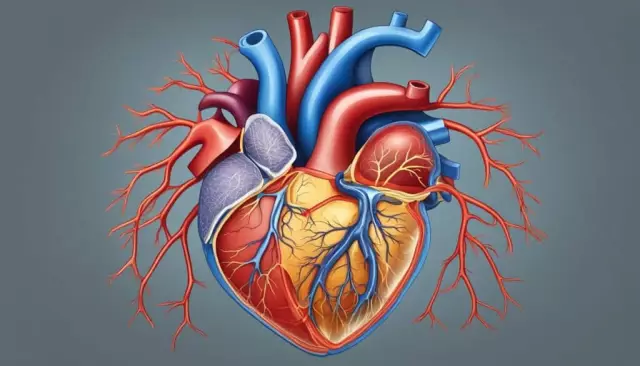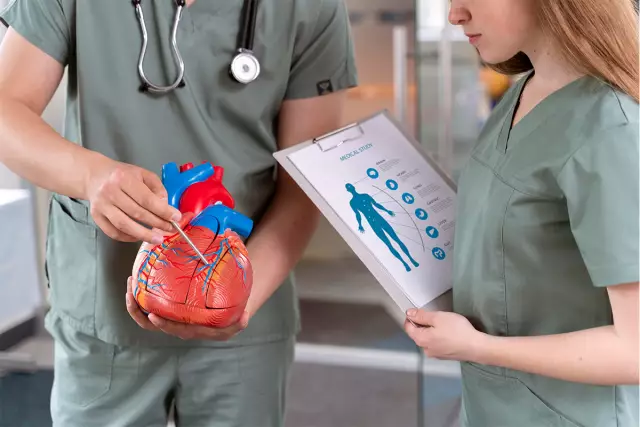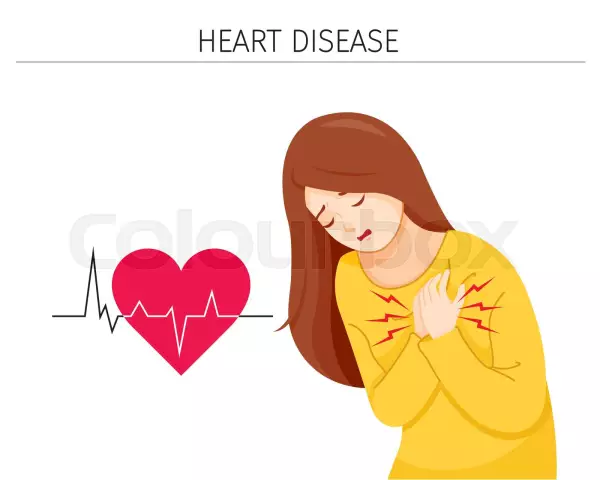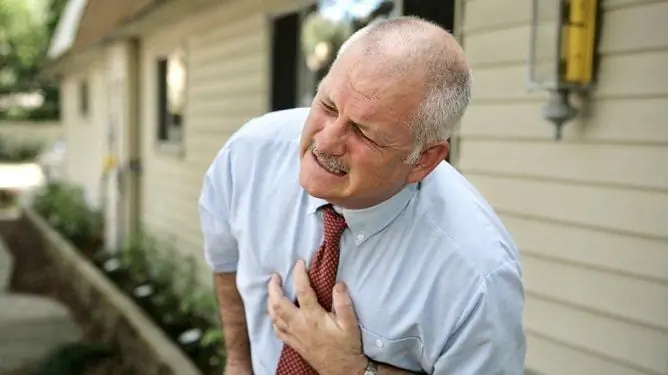- Author Rachel Wainwright [email protected].
- Public 2023-12-15 07:39.
- Last modified 2025-11-02 20:14.
Cardiac ischemia
Brief description of the disease

According to statistics from the World Health Organization, coronary heart disease is the most common and most severe therapeutic problem in modern society. Such conclusions are made on the basis of the fact that every year more and more people suffer from this disease, and the incidence of the disease is constantly growing. It is especially dangerous that ischemic heart disease, the causes and manifestations of which are extremely diverse, often leads to a complete loss of working capacity and is the leading cause of early death in people.
Similar consequences are associated with insufficient blood supply to the heart muscle. This pathology is called "ischemia". In most cases, it is a consequence of arterial atherosclerosis, a process in which the arterial lumen narrows significantly due to the formation of plaque. Currently, hundreds of specialists continue to work on solving this problem and try to understand what ischemic heart disease is. The causes, symptoms and clinical picture of the disease are being investigated, a huge amount of factual material has been accumulated, however, it is too early to talk about a complete victory over the disease. Ischemic heart disease, the symptoms of which are manifested mainly in old age, continues to take people away, regardless of their gender and social status in society.
Of course, modern diagnostic equipment greatly facilitates early detection of the disease and even allows one to assess the predisposition to a particular problem of the cardiovascular system, but this is clearly not enough. Considering how dangerous ischemic heart disease is, the state should take control of the treatment of this disease, because it is no less interested than its citizens in the fact that men and women do not leave life in their prime.
Ischemic heart disease - symptoms of pathology
The first signs of coronary heart disease are almost always subjective, that is, the patient has unpleasant, painful sensations, but for the time being he does not attach much importance to them, believing that everything will pass by itself. Meanwhile, the basis for contacting a cardiologist is absolutely any pain in the heart area, especially if they have never bothered a person before. In addition to minor tingling sensations, coronary heart disease, the causes of which are often associated with an improper lifestyle, can manifest itself in the form of attacks. They are also a reason to immediately see a doctor, regardless of the duration and intensity of pain. Let's note some other characteristic symptoms of coronary heart disease:
- pain in the chest, arms, lower jaw, and back;
- shortness of breath that occurs even with minor physical exertion;
- nausea, vomiting;
- excessive sweating;
- heart palpitations, heart rhythm disturbances;
In general, when diagnosed with ischemic heart disease, symptoms are highly dependent on the form of the disease. It happens that the pathology of the cardiac system does not manifest itself at all until the sudden death of a person, which happens, for example, with myocardial infarction. However, the approach of trouble can be determined by indirect signs, which include: unexplained attacks of fear, unpleasant sensations in the chest region, nervous breakdowns and emotional disorders. The direct symptoms of sudden cardiac death are loss of consciousness, absence of heart sounds, dilated pupils, and a pale gray skin tone.
Despite the prevalence of sudden deaths, the most typical symptom of coronary heart disease is still angina pectoris - local pain in the retrosternal region, manifested, as a rule, on the left side. Note also that if a person is diagnosed with coronary heart disease, the symptoms of angina pectoris tend to be intense. In fact, the nature of the pain ranges from mild discomfort to unbearable pain, accompanied by anxiety, sweating, nausea and general weakness. Angina attacks are short-lived. In most cases, they last no more than 10 minutes, and therefore, many people do not pay enough attention to them. It should be borne in mind that ischemic heart disease, which is not treated or carried out without following established procedures, is constantly progressing,leads to disturbances in the work of the cardiovascular system and, ultimately, the death of a person.
Another characteristic sign of coronary heart disease is attacks of myocardial infarction. At the initial stage, a heart attack can be confused with angina pectoris, but later on it develops in a completely different way. In particular, it can be noted that attacks of chest pain last much longer and are not relieved by taking nitroglycerin. At the same time, a person's blood pressure rises, a state of suffocation occurs, the temperature rises and heart rhythm interruptions are observed.
Summarize. Ischemic heart disease, the causes of which are extremely varied, can occur in every person. It develops slowly but surely, over the years destroying the heart system. Accordingly, the sooner a person seeks a doctor, the higher the chance to maintain their ability to work and live a normal, full life until a ripe old age.
Coronary artery disease - treatment of the disease

I would like to say right away that traditional medicine is very difficult to cope with the symptoms and consequences of coronary heart disease. Treatment in this case is long, difficult and necessarily consistent. The main problem is that at present doctors do not have the technologies that would allow replacing damaged connective tissues with healthy ones without significant risk to the patient's life. For this reason, when diagnosed with coronary heart disease, treatment involves strengthening the healthy part of the tissue with the help of various drugs and constant monitoring by a specialist to prevent attacks.
In recent years, several methods have appeared that allow us to move away from the use of classical, ineffective methods of treating coronary heart disease. One of them consists in replacing damaged tissues with healthy ones with the help of stem cells, which form a capillary network of vessels and restore normal blood supply to the heart. At this time, stem cell treatment is successfully used in many clinics around the world and let's hope that, sooner or later, this technology will be adopted by domestic specialists.
YouTube video related to the article:
The information is generalized and provided for informational purposes only. At the first sign of illness, see your doctor. Self-medication is hazardous to health!






